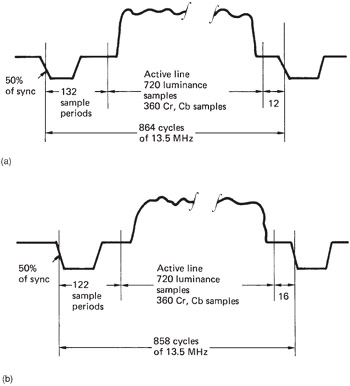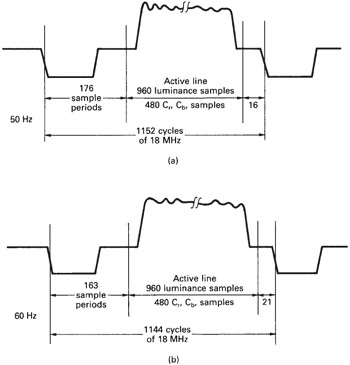7.4 Structure of SD Component Digital
| | ||
| | ||
| | ||
7.4 Structure of SD Component Digital
The sampling rate for luma is H-synchronous 13.5 MHz. This is divided by two to obtain the colour difference sampling rate. Figure 7.7 shows that in 625 line systems the control system 4 waits for 132 luma sample periods after an analog sync edge before commencing sampling the line. Then 720 luma samples and 360 of each type of colour difference sample are taken; 1440 samples in all. A further 12 sample periods will elapse before the next sync edge, making 132 + 720 + 12 = 864 sample periods. In 525 line systems 5 , the analog active line is in a slightly different place and so the controller waits 122 sample periods before taking the same digital active line samples as before. There will then be 16 sample periods before the next sync edge, making 122 + 720 + 16 = 858 sample periods.

Figure 7.7: (a) In 625 line systems to CCIR-601, with 4:2:2 sampling, the sampling rate is exactly 864 times line rate, but only the active line is sampled, 132 sample periods after sync. (b) In 525 line systems to CCIR-601, with 4:2:2 sampling, the sampling rate is exactly 858 times line rate, but only the active line is sampled, 122 sample periods after sync. Note active line contains exactly the same quantity of data as for 50 Hz systems.
For 16:9 aspect ratio working, the line and field rate remain the same, but the luminance sampling rate may be raised to 18MHz and the colour difference sampling rates are raised to 9MHz. This results in the sampling structure shown for 625 lines in Figure 7.8(a) and for 525 lines in (b). There are now 960 luminance pixels and 2 — 480 colour difference pixels per active line.

Figure 7.8: In 16:9 working with an 18 MHz sampling rate the sampling structure shown here results.
| | ||
| | ||
| | ||
EAN: 2147483647
Pages: 120
- Challenging the Unpredictable: Changeable Order Management Systems
- ERP System Acquisition: A Process Model and Results From an Austrian Survey
- Enterprise Application Integration: New Solutions for a Solved Problem or a Challenging Research Field?
- Context Management of ERP Processes in Virtual Communities
- Relevance and Micro-Relevance for the Professional as Determinants of IT-Diffusion and IT-Use in Healthcare